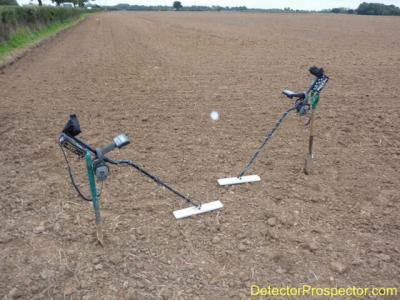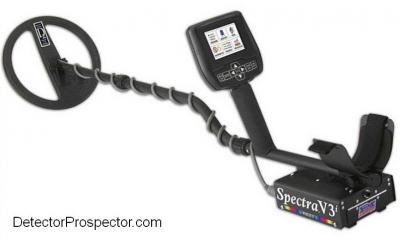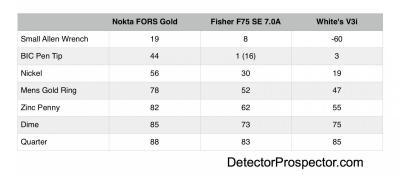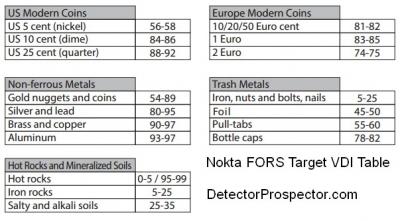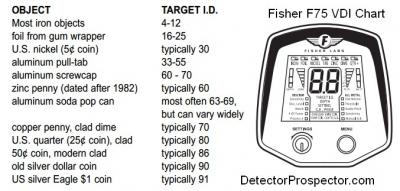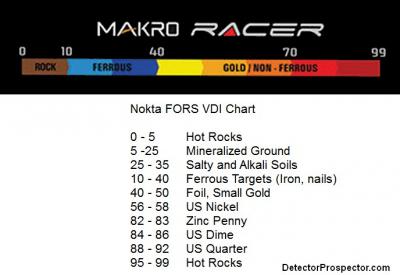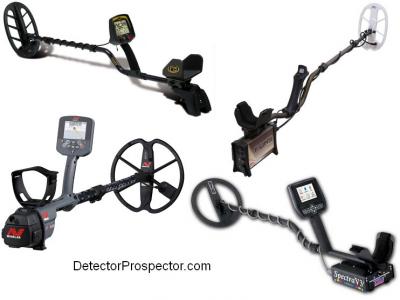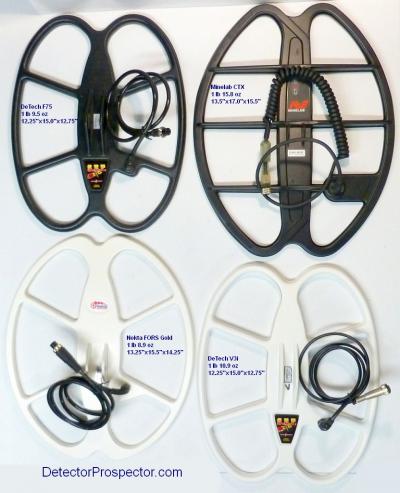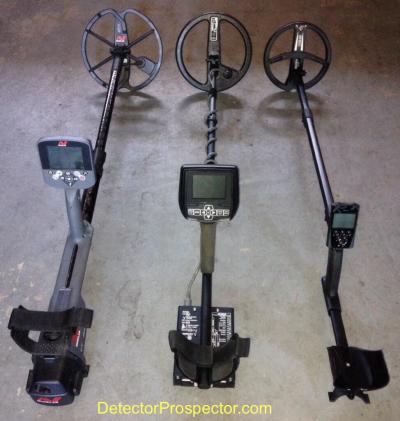Search the Community
Showing results for tags 'dfx vx3 v3i'.
-
I have a White's DFX that is perhaps my favorite park jewelry detector, though my Minelab CTX 3030 threatens to change that. The trump card for the DFX still is that I have a rare and highly sought after Big Foot coil. The Big Foot is a 3" x 18" coil specially wound internally in a figure 8 pattern that eliminates electrical interference and allows the use of the front half of the coil for pinpointing with the DFX, which was designed with the coil in mind. The coils were hand made by Jim Karbowski who called his company Applied Creativity. Jim unfortunately passed away in 2007 and the coils now go for far more used on eBay than they ever did new. http://www.gazettetimes.com/news/local/obituaries/james-karbowski/article_c8505ae6-50ec-5639-8a21-33a96b718ad4.html The coils are labor intensive and despite lots if lobbying I never could get White's to make them. When White's announced the V3 I was excited by what I see as a "Super DFX". The DFX allows you to run either 3 kHz or 15 kHz or both together. It is highly programmable, too much so for many people but for me it pretty much turned into a 15 kHz detector to drive my Big Foot coil. The Big Foot is not made for depth, but at 18" long it is great for sweeping large parks or sports fields cherry picking targets. Here is my Big Foot attached to my old MXT in the UK, sitting next to a friends unit similarly outfitted. Huge fields like that in the photo is where the Big Foot shines. The V3i runs at 2.5 kHz, 7.5 kHz, and 22.5 kHz, all together or each separately. It can do all sorts of frequency comparison tricks and has the best color display on the market, that can be programmed to show an amazing array of target response and information. Again, maybe too many settings for some people - this set of note by V3i engineer Bob Canaday will give you an idea of how complex adjusting the V3i can get http://www.metaldetectingintheusa.com/files/bob-canaday.pdf A tweakers dream however, and it works with the Big Foot, but not perfectly, as some target VDI information is skewed at different frequencies. Good enough though. I really wanted to love the V3i! The problem is with two different units I ran into serious electrical interference issues with the V3i in Anchorage, Alaska, my old home town. The same places where my Fisher F75 would shut down. The main culprit was buried power lines, which in Anchorage meant nearly all parks, school yards, and other places I might want to use a metal detector. I worked with White's on the issue to no avail, my main suggestion being that a figure 8 wound EMI coil be made specifically for the V3i, but it never came to pass. Sadly for me, I just finally gave up on the V3i. Then I ran into a guy named Marko at Ganes Creek in two different years. He was running the V3i in the 22.5 kHz Prospecting Mode with a Detech 10" x 12" SEF coil. Marko killed it at Ganes Creek two years in a row with the V3i finding many nuggets large and small. Everyone gets lucky now and then but Marko consistently did well, and I always pay attention when I see results like that. You can see pictures of Markos 2011 finds at http://www.whiteselectronics.com/finds/?view=gainesgold Fast forward to my moving to Reno, Nevada. It has crossed my mind now and then whether the V3i might behave better here. I still am intrigued by the 22 kHz mode, perhaps for hunting the miles of cobble piles around here looking for that big gold filled cobble. You need something with a combination of depth and good ferrous discrimination for that, and Markos results still intrigue me. The kicker however is that I have a new XP DEUS detector on the way. The Deus has many of the programmable aspects of the V3i and can run at 4, 8, 12, or 18 kHz, though only one of those at any one time. The V3i offers more ability to actually identify targets, but the Deus is reputed to be much better at target separation. So I have a V3i on the way. People may wonder how I can afford to load up on detectors like this. Well, being in the industry for 35 years has advantages, and one if them is I get my detectors nearly always for less than I can sell them for later. I do have money tied up in them but it basically rotates as I sell one and get another. I am not pouring money into detectors. That being the case, I find it worthwhile strictly from the aspect of satisfying my own curiosity and continuing my never ending education in all things metal detecting. The fact is though I will be selling a bunch of detectors and accessories this winter. I will be doing lots of testing and comparisons and then deciding eventually what goes and what stays. That in itself ends up being the most important test of all. The good news is you all get some of the benefit I derive from all this craziness! White's V3i Advanced Users Guide https://www.detectorprospector.com/files/file/33-whites-spectra-v3i-advanced-user-guide/
-
Hi Steve, I'm down here in Oz and was considering considering an MXT Pro. Would I be better off going to the V3i? Best regards....Robin
-
Hi Y'all. I've been all over the map as far which detector I think I'm going to buy. Right now I think it's either going to be the CTX3030 or White's V3i. I got some questions. How does the Minelab's auto ground balance technology compare to White's auto ground balance technology? In particular, in terms of ground balancing, how does the CTX 3030 compare to White's V3i? How do the discrimination abilities of the CTX3030 and V3i compare? White's user manuals are written much better than Minelab's user manuals. How much do you agree with this statement? Minelab claims, "FBS (Full Band Spectrum) simultaneously transmits, receives and analyses a full band of multiple frequencies." Whiteselectronics claims, "... digital waveforms also produce unde- sired harmonic frequencies. Lots and lots of harmonic frequencies, 10’s or even 100’s of them. These harmonics have no useful energy and are not part of the signal processing. So while we can claim to transmit many, many frequencies, we cannot claim to process or use them. Therefore, we could easily claim the Spectra V3i transmits 17 frequencies, or 28, or 39, or 55—we could get plain silly with this. And such a claim would be true, technically speaking, but since all those extra frequencies are not actually used, it would be misleading to make such a claim. White’s chooses, instead, to claim the number of frequencies we are actually using and processing. It may not sound as impressive as a 55-frequency detector, but it’s honest and accurate. " So, either Minelab's claim is false, or White's multifrequency technology is not as sophisticated as Minelab's, which is it? Or I'm misinterpreting something. - Nugz
-
The rumor mill is cranking up fast about a possible new release from White's Electronics, the White's V4 Link deleted since Findmall Forum update broke all old links http://www.dankowskidetectors.com/discussions/read.php?2,71980 Multiple frequencies, PI mode, etc. Perhaps something taking advantage of one of White's new patents? The Half Sine patent in particular seems applicable. White's Electronics Half Sine Technology Patent White's Electronics Constant Current Technology Patent White's certainly is due for something new. Rumors are saying March/April. Looks like 2015 really might go down as the year metal detector technology made a real leap forward. But then again - it is all just rumors.
-
Snow on the ground so time for a little bench testing. Fisher F75 SE version 7.0A (2013) with 5" round DD coil, Nokta FORS Gold with 5" semi-round DD coil, and White's V3i with 4" x 6" DD coil. The table shows VDI numbers on some standard items. The little allen wrench is like a small nail - a ferrous item. The BIC ballpoint is my standard simulated small nugget. The ring is my 14K plain gold band, around 7 grams. The VDI range on the Nokta runs from 1 - 99 with 40 and under generally ferrous. The F75 runs from 1 - 99 with 15 and under generally ferrous. The White's V3i runs from -95 to +95 with negative numbers generally ferrous. I say generally because in all three cases gold can run well into the ferrous range. Like by 10 - 20 VDI numbers into it! A few big lessons. The Nokta FORS VDI 1 - 99 range is skewed with high conductors bunched on the high end of the scale with most of the scale devoted to ferrous and low conductive items. This is ideal for relic hunters and prospectors. Silver coin hunters however usually prefer the scale to devote more room on the high end to possibly get a better handle on what is silver and what is not. The ferrous range of the Nokta actually runs all the way down into the ferrous ground range itself which is why there are 40 numbers devoted to it. The ID Mask setting defaults to 10 and if set lower allows ground signals to sound off. Since non-ferrous starts at 40 and I arbitrarily end low conductors at zinc penny on the upper end you have 40 - 82 or a spread of 42 points for low conductors. This really is no more than an average spread due to the large ferrous range. What I was happy to see is the simulated nugget (BIC ballpoint) nailing at 44 as a non-ferrous target. Contrast this to the F75 1 - 99 range. There are only 15 points in the ferrous range with the extreme low end represented on the Nokta scale truncated roughly in the middle. However, this leaves 16 up to 62 at zinc penny for a low conductor spread of 46 or slightly better than that on the Nokta FORS and leaves room for a little better definition for high conductive coins also. There is a ten point VDI spread between a dime and a quarter versus only 3 points on the Nokta. What disturbs me on this particular F75 is that having tried multiple coils I am getting the same result on the simulated nugget test. It wants to nail at a solid 1 which is well under the ferrous 8 reading for the allen wrench. This is not shocking but it is not good either. I can get the ballpoint to break in at 16 occasionally but it should be there hard and solid, not rarely. I had Keith Southern test his updated F75 and it seems to do better. I need to test this again when and if I ever get an upgraded F75 but it does confirm my suspicion that at least some Fisher units are not properly aligned at this critical break point. The White's V3i slays both of them with White's standard spread of 190 VDI points with half that devoted to ground and ferrous. A full 95 points is devoted to non-ferrous, giving a nice spread across the whole range. The V3i is a three frequency unit and the 22.5 kHz frequency employed allows it to easily nail the ballpoint test with a solid VDI of 3. White's even allows the 22.5 kHz frequency to use a native VDI range that skews and expands the low conductive range that delivers a VDI of 10 on the ballpoint, a very nice cushion between it and a ferrous reading. you have from 1 all the way up to 55 for zinc penny slightly beating both the Nokta and F75 for VDI resolution on low conductors and still room left for very good definition in the high conductor range. These detectors can employ a dual tone mode that delivers a low tone on ferrous targets and a higher tone on non-ferrous targets. The break point on the Nokta and F75 is preset at the factory VDI breaks of 13 and 40. The V3i you can customize not only the VDI break point but the tones. The F75 dual tone mode is pretty straight forward, with the volume being weaker or louder depending on the strength of the signal. In other words, a modulated audio. The Nokta Boost or DI2 mode uses a VCO (voltage controlled oscillator) audio where both volume and tone increases with signal strength. Anyone that uses a Fisher Gold Bug is familiar with VCO audio. It is rather unique and some people like it, others do not. Again, the V3i allows the tones to be customized any way you want, with either VCO, modulated, or even unmodulated options. Things get more interesting in Nokta DI3 or F75 three tone options. The low tone break for ferrous is the same but a third higher tone is added. On the Nokta zinc pennies and higher or from 80 on up delivers the third high tone. On the F75 it breaks above zinc penny so those pennies fall into the middle tone low conductive range. Zinc penny is also where Indian head pennies and some other old coins can fall. If you hunt strictly by ear and dig high tones only you are going to pretty much dig all coins but nickels. With the F75 it is geared more towards silver hunters so zinc pennies, Indian heads and possibly other coins would get passed up as low conductors. But wait! The F75 also has a four tone option that puts that zinc range into into own fourth tone - problem fixed. You can chose a tone option that focuses more on silver only or one that breaks out that penny range. Jewelry Hunter would probably prefer the 3 tone mode and dig just mid-tones. The bottom line is the Fisher has more tone options for the coin hunters than what the FORS offers. Of note is that the Nokta DI2 dual tone mode uses VCO audio, but the DI3 three tone option defaults to a more normal modulated audio. DI3 favors a faster sweep speed than DI2 which benefits from going slower. A generality would be that DI2 is more powerful but DI3 better behaved. The V3i again is unchallenged. You can actually go so far as to independently set a separate tone for every single VDI number, and the tones can be any from 191 tone options. You can make low conductors high tone if you want. Absolutely nothing on the market compares to the V3i for audio and visual customization options. Well, this all seems pretty easy, right? Just get the V3i and get on with business. Sadly, these are air tests. You might ask, for instance, which detector did best for "depth" in these air tests, as if there actually is such a thing. I only pay passing attention to that but the F75 seemed to be doing very well in that regard. Here is the problem with this entire lesson and all my typing. When you put things in the ground all these nice air tests rapidly decay and fall apart. In very mild ground or on very shallow targets detectors can be amazing. In my ground unfortunately VDI numbers start breaking down at around 3-4 inches! What you discover is that if you get too focused on cherry picking VDI numbers good finds deplete rapidly. Almost all accessible public areas have been detected for decades. So the easy accurate VDI results have already all been cherry picked away. The best finds these days often come from digging targets that were passed up precisely because they did not give a perfect response. In my opinion, these days we have to cast a wider net and be willing to dig more trash to make those exceptional finds. What that means is huge numbers of VDI numbers and tones although flashy and fun often is no better than just using a simple two or three tone method and going for it. Styles differ vastly and because really this is about enjoying ourselves there is no right or wrong way to do things - as long as you are enjoying yourself. For me, something simple like the Nokta DI3 tone option for digging all high conductor possible coin signals actually works pretty well in actual practice. If I want coins except nickels just dig high tones and have fun. The F75 allows a special mode that kicks nickels into the high tone range so you can do the same thing and get the nickels also if you choose. The V3i by now you should know the story - set it up any way you want. Still, tests like these are very valuable to me in setting the baseline for performance in the field from which I can work to discover how much things vary and hopefully why. The theoretical goal if finding a machine that adheres as closely to bench testing results as possible in the field. Sometimes you get textbook results, but then at another location everything goes haywire. But unless you know where you are starting from you will have no idea what is going on. I will sum this up for now by saying that the Nokta FORS is a machine that appeals to simplicity and leans towards relic hinting and prospecting. That is not to say you can't do well coin detecting with it, it is just that it is not set up with coin detecting specifically in mind. The F75 nicely straddles the middle for all detecting purposes. The V3i is in theory the perfect detector but the reality is huge numbers of people have discovered more options does not always mean better detecting, and it is not unusual at all for people to abandon the V3i in favor of simpler machines. Unless you spend a vast amount of time with a V3i it is hard to feel like you have mastered the machine. The V3i appeals to my inner detector nerd but it is usually the case where in the field I prefer simpler machines myself. Still, I made the V3i part of all this just to see how it really does do if given a fair chance and at least when bench testing it is impressive to see all the bells and whistles in action. This is all just stuff I am finding out for myself. I have no real reason in reporting it to you other than just to be sharing some info that is taking at least a little effort to collect. It helps me digest it better trying to put it clearly in a form you can better understand. Hopefully it will help someone in their own choice in a detector. As you may be figuring out if you have not already, there are no best VLF detectors, just lots of really different VLF detectors. They all actually do a good job finding stuff but it is in how they go about it that differs so much. It is mostly a case of finding out what style and type of detector works best for you.
- 7 replies
-
- 3
-

-
- fisher detector
- nokta fors
-
(and 1 more)
Tagged with:
-
This should be interesting. The reality these days is that when it comes to nugget detecting I am very much a pulse induction kind of guy. I also go out of my way to point out the problems with using VLF detectors and discrimination while nugget detecting. Yet at the same time I have very much been a proponent of using VLF detectors and discrimination where it may offer some sort of advantage. Ganes Creek, Alaska was the best example of a location with large nuggets and tons of ferrous junk to contend with. A good discriminating VLF detector made sense there and the vast majority of the gold found at Ganes Creek was found with VLF detectors. I am seeing similar situations here down south, especially in California. Places where 150 years of mining has left ferrous trash galore. What I am looking for is a way to narrow things down a bit in some situations. The idea in some places with unknown potential is to scout first with the VLF, and then, if any gold is found, to switch to a PI and hammer the spot. There are the big cobble piles, that may have a big cobble shot full of gold, but which are more likely to contain a rusted can. A big coil on a VLF could be handy for scouting those. Finally, I want to do some honest blue sky prospecting where I put myself in gold country but not specifically on a proven location and go looking for a patch. A lot of this would be in logging country and steel wire and other ferrous trash can be common. I can deal with the bullets but may want to weed out the ferrous. I ended up by chance with a Nokta FORS Gold that came with a 13.5" x 15.5" DD coil. This machine has a great two tone mode where all targets signal, but ferrous with a low tone, and non-ferrous with a high tone. My preferred mode for scouting trashy terrain. I hear all targets so nothing gets passed without thought. I may investigate some ferrous signals further if I am suspicious. I have a new Fisher F75SE coming, a model without the latest updates. I may end up also with an updated version but got tired of waiting on that so bought this one to use for now. It also gives me a baseline to compare to should I ever lay hands on a newer unit. Or one I can upgrade later if I wish. To compare apples and apples I have a new DeTech 12" x 15" DD coil on the way for the F75 to use versus the Nokta with similar coil. I have a friend who did very well at Ganes Creek in the 22.5 kHz dedicated frequency prospecting mode, and his main claim was that it had killer discrimination. So just to make life interesting I have another DeTech 12" x 15" DD coil on the way to use on the V3i versus the other two detectors. Finally, I will toss my CTX 3030 with 13" x 17" coil in on this little competition though it is a slightly different coil. Close enough though and should be interesting. There is already a huge thread going on the CTX and gold at http://www.detectorprospector.com/forum/topic/361-minelab-ctx-3030-for-gold-nuggets/ I honestly look at this as more a shootout between the F75 and the Nokta more because I see them more as get down and play in the mud prospecting detectors. The CTX and V3i are more my in town units. But maybe that is just a perception thing on my part and since I own both anyway - why not? Looked at another way these do represent some company flagship units, say what else you may about them. Maybe there will be surprises and no matter what, I have a lot to learn here. And that, my friends, I do enjoy! OK, now the bad news. I am not much for contrived testing so I will need favorable weather to get these detectors out of town into real field conditions to give this all a try. And I do not want to rush to judgement in any case. Eventually it will all sort out and I will report along the way if anything of interest develops. Until then, you will have to be patient. Again, lest anyone think I am believing this all to be some kind of magic gold getting idea, it is not at all. I will be using a PI detector for most of my nugget detecting in 2015 and basically digging everything I come across. This is actually part of my weeding down detectors process with the main goal being to let either the F75 or FORS Gold go away. I have other reasons for keeping the CTX and V3i so they are just going along for the ride and the potential for extra knowledge. When I go out this summer I want to be packing both a PI and a VLF. The intent is to use the PI and have the VLF more for backup or for getting into a real trashy location. This shootout will determine just what VLF gets to go with me this summer. The photo below shows all four coils side by side with weights as weighed on my postal scale with scuff covers. The dimensions are width by length at longest point with the third dimension being the length of the actual middle DD overlap working area. The two DeTech coils are 12.75" in this regard versus 14.25" for the Nokta and 15.5" for the CTX 3030. This would be the nominal length to shoot for on each coil sweep if you figure no overlap (which would not be wise). The Nokta is the lightest coil so in theory combining weight with area covered it has the best overall specs as regards area covered for weight handled. The angle of the picture and coil placing tends to make the Nokta coil look smaller than the DeTech coils but it is in fact slightly larger. Last funny note. I would normally complain about putting coils this size on VLF detectors because in the past it made them nose heavy and had me whining about the weight. However, world class lead weight PI detectors have made it so I have gotten used to using machines far heavier than these beasts, even with their larger coils. Go figure.
- 5 replies
-
- 3
-

-
- dfx vx3 v3i
- minelab ctx 3030
-
(and 1 more)
Tagged with:
-
just wondering if you are close to posting up a review. (I have read what you wrote so far)
-
Here are three detectors that offer three different ways to do multi-frequency. First up, the detector on the right, the XP DEUS. This detector allows you to choose from one of four different frequencies, and run any single one at a time. You can choose from 4, 8, 12, or 18 kHz. Second, we have the detector on the far left, the Minelab CTX 3030. This detector looks at a range of frequencies and analyzes several at once. Transmitted frequencies is a bit of marketing magic; all that matters is what a detector processes. The CTX 3030 processes two or three frequencies simultaneously, comparing the results with advanced algorithms to deliver target information. There is no option to process single frequencies. Finally, the detector in the middle, the White's V3i. This detector employs three frequencies, and is unique in that it can process and compare results from all three simultaneously, or run any one single frequency. The choices are 2.5, 7.5, and 22.5 kHz. In a nutshell low frequencies are less reactive to ground minerals and produce cleaner signals on coin size high conductive targets. Low frequencies also better discern ferrous from non-ferrous items. High frequencies are more reactive to ground mineralization and have more issues identifying ferrous trash, but respond better to small low conductive items. Frequencies under 10 kHz tend to be "coin frequencies", 10 kHz to 15 kHz is a good "all around frequency range", and over 15 kHz tends to be the realm of prospecting detectors, though higher frequencies are seeing more use now with others attempting to pull small non-ferrous items out of ferrous trash. European hunters looking for small coins and relic hunters looking for bullets and other items are leaning higher frequency these days. Usually choosing a single frequency will deliver the most power and depth. That is why you do not see multi-frequency nugget detectors, and why out of the three detectors discussed here the Deus with its 18 kHz mode and V3i with its 22.5 kHz mode offer better potential as prospecting units than the CTX 3030. Detectors that process multiple frequencies have a clear edge when running on mineralized salt water beaches. A single frequency can handle the mineralization, or the salt effect, but not both at once. Multi-frequency detectors are the preferred solution for salt water beach applications (not counting PI detectors), and so the CTX 3030 and V3i have a clear edge over the Deus in this regard. Multiple frequency analysis can offer superb discrimination capabilities. When people talk about depth on multi-frequency detectors what they are really talking about is accurate target identification at depth. Many detectors will detect deeper than the multi-frequency units, but not while delivering accurate target id results. The Minelab Explorers and CTX are generally acknowledged as being on the forefront in this regard, no doubt due to the highly secret algorithms they employ to deliver target id results. Anyway, the three detectors here have three different ways of handling the options. In theory the V3i offers the best of both worlds - the ability to run any one frequency or three at once. In practice the V3i is so complex few people ever fully master its capabilities but I do think they have the right idea. A much requested idea for the XP Deus, which is updateable via software, is the ability to run multiple frequencies. On salt water beaches at least this offers an indisputable advantage. Presumably an update to the CTX could offer the ability to run a single frequency, but so far Minelab has shown no interest in such options. It does appear that is where we are heading though - detectors that through proper design and software can become most anything the operator desires.
- 2 replies
-
- xp deus
- dfx vx3 v3i
-
(and 1 more)
Tagged with:


